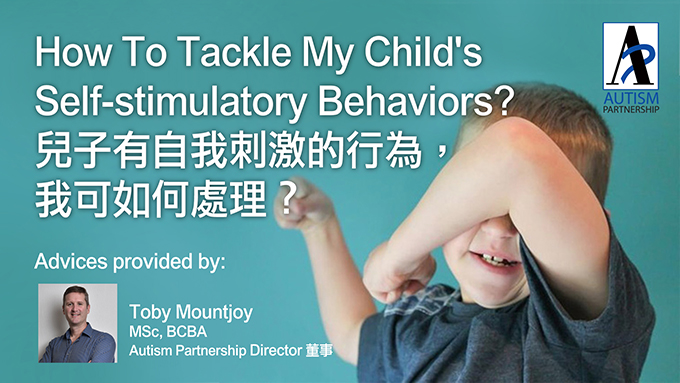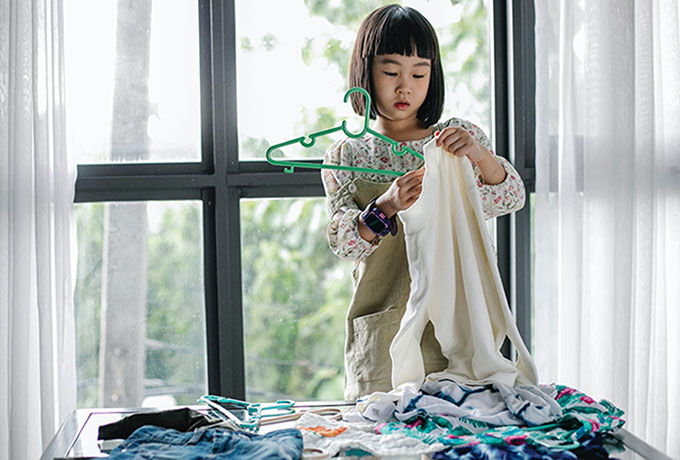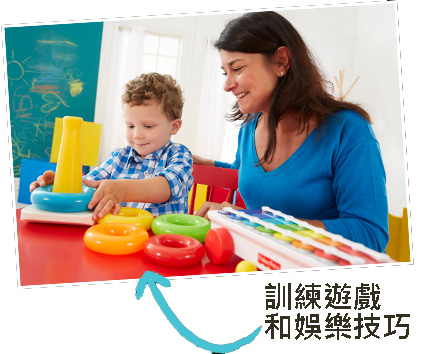
Parent’s Question:
My son is 6 years old and is diagnosed with ASD. After 2 years of training, he can greet people spontaneously with eye contact. However, he still engages in shaking head, flapping hands, etc. All those self-stimulatory behavior makes me feel embarrassed when we are in the public. Except yelling at him to make him stop, anything else I can do?
Self-stimulatory behavior and what to do about it is a very common question from parents and often becomes more in the spotlight as children get older. Often, when the children are still young, it may be less of priority but as the children get older, it begins to highlight their ASD and can be socially ostracizing.

It is important to understand the reasons behind such behavior, which might seem odd and unusual. In fact, we all have self-stimulation! We touch our hair, tap our feet, curl our toes, chew gum, etc. The major reason is just because it feels good! It passes time and engages our senses when we feel bored. It also can give us some outlet when we feel stressed as it may allow us to release the negative feelings that are associated.
For many children with ASD, it is the same. They may have poor leisure skills and not very good social interaction skills, but they have many hours a day where they have free time. It might be common to see children with ASD engage in self-stim during these times to pass the time of day.
One critical difference we can see is that for most typically developing people, they regulate their self-stim so that it does not interfere with their learning and they may only do it at low levels so that they do not stand out. It is highly regulated by our desire to not appear odd.
However, for children with ASD, they may not understand the social world as much or care very much about what others think about them. As a result, their self-stim behavior may happen with more intensity and regularity.
There are many ways to tackle this problem. First is that we believe it is not a need. Some people will see self-stimulation as a need but we do not think this is the case. If you were to see someone eating a lot of chocolate cake very often you would not necessarily think just because they do it often they have a need. We would see self-stimulation as more of a preference and desire (something they like to do) and sometimes as a coping mechanism for stress



Again, don’t be afraid to intervene in the self-stim behavior. It will not cause any damage or cause any problems. Actually the more the child engages in the self-stim, the worse it becomes over time. It is often not a behavior a child will grow out of unless intervention is applied. However it is critical that you do not just keep stopping the behavior. You need to direct and teach the child something else to do. This is most important!
For children that are more anxious or use self-stimulation as a stress release strategy, it is more complicated and we will deal with this and advise some other strategies in future articles.
  | Toby Mountjoy Mr. Toby Mountjoy is a Board Certified Behavior Analyst and holds a Master of Science in Applied Behavior Analysis. With over 20 years of experience working with individuals with ASD, he has been extensively trained by Dr. Ronald Leaf, Dr. Mitchell Taubman and Dr. John McEachin. Besides overseeing the Autism Partnership operation in Hong Kong, Korea, Philippines and Singapore with over 100 staff, including psychologists, consultants and therapists, he has also provided consultations to school districts, agencies, and families worldwide. Mr. Mountjoy has also contributed chapters to publications such as “Sense & Nonsense” and “It’s Time for School”. In 2007, he founded the charitable Autism Partnership Foundation and AP School to offer more services for children with Autism. |
AutismPartnership 的建議:
在我超過二十年治療自閉症患者的經驗當中,常遇到家長提問有關如何干預孩子的自我刺激行為的問題。其中,大部分孩子的年紀都相對地年長。幼兒年紀小,還不懂事,問題大概並不急切;但是,隨着孩子成長,自我刺激行為逐漸突出,甚至惹來外間歧視目光。
雖然行為看來既奇怪,又不大尋常,但是明白沉迷於這些行為背後的原因卻是一個重要的關鍵。環顧四周,你會察覺到其實正常發展的人也同樣有一些自我刺激行為,例如:有些人總是常常撥弄頭髮、抖腳、把腳趾捲起,咀嚼口香糖等 ‧‧‧我們作這些行為的原因很簡單:就是想要得到那種過癮的感覺。它能消磨時間;在沉悶時,又能刺激五官。有時候,這些行為甚至是我們消減壓力和困擾的渠道。

其實,自閉症孩子的情況也是一樣。他們大部分的遊戲和社交技巧都相對較弱,導致孩子一整天都百無聊賴,唯有借著沉迷在自我刺激行為來消磨時間。正常發展和患有自閉症孩子的差別就是在於這些行為不至於影響他們學習,以及日常生活,而且,這些行為的頻繁和強烈程度都不至於突出。由於我們某程度上都在意別人對我們的看法,所以我們都克制自己的行為,使其不至奇怪。相反,基於部分自閉症孩子對社交認識的缺乏或對別人看法的不在乎,令他們的自我刺激行為頻繁和強烈得多。
處理自我刺激行為的方法有很多。首先,我們要相信這些行為並不是一種需求。外間有些人會視這些行為是自閉症孩子的一種需求、是必要的,我們卻不贊同。我試舉例:我們不會視一個巧克力愛好者瘋狂吃黑森林蛋糕的行為為需求。同樣地,我們視孩子的自我刺激行為為愛好和渴望,有時候,亦可能會是用來舒減壓力或困擾的應對方法。


1. 建立和教導適當的替代技巧:語言和認知很多時候都是自閉症孩子的課程重點,但遊戲和娛樂技巧卻很容易被忽略。一個有效的遊戲技巧能教導孩子如何有建設地利用他們的自由時間。大家可嘗試有系統地把遊戲技巧逐步拆細,然後一步步為孩子提供訓練,這是一個能有效地減少孩子作自我刺激行為的好方法。
2. 建立和教導日常生活常規或家務:孩子越來越大,教學範圍亦不再局限於遊戲技巧,家長也可考慮教導孩子一些適齡的家務,例如:準備晚飯常規﹝於晚飯時間前在飯桌上為每人放置一套餐具,亦是一個不錯的選擇。

3. 在你教導了一些以上兩點提及的技巧後,你對干預孩子的自我刺激行為就會倍感容易。由於孩子已學懂了一些替代技巧,你只須在孩子作這些行為的時候作出停止,然後把他們的專注力轉移到他們已學懂的遊戲或家務上。
4. 在孩子沒有作這些行為的時候或在他們有建設地利用時間時,把握時機,提供鼓勵、讚賞和獎勵。有些情況可能需要採用到一些具體的行為制度。由於行為制度的程序頗為複雜,家長有機會需要一些訓練才能更有效地採用,我們將來會就著行為制度再多作解釋。

假若孩子作自我刺激行為的目的是作舒減壓力或困擾的話,由於這相對地較為複雜,處理手法也不太相同。我們會在日後的文章裡討論。
資訊提供: Toby Mountjoy (董事)
  | Toby Mountjoy 董事Toby Mountjoy先生是註冊行為分析師 (BCBA),持有「應用行為分析學」碩士學位。於治療各類型的自閉症人士有超過20年經驗,且得到Ronald Leaf博士、 John McEachin博士及Mitchell Taubman博士的悉心培訓。 除了監督及帶領AP在香港、韓國、菲律賓及新加坡分部逾100名員工,當中包括臨床心理學家、應用行為分析顧問及治療師,亦為世界各地的學校、機構及家庭提供諮詢服務。Toby Mountjoy先生曾為數本有關治療自閉症的書籍撰寫部分章節。另於2007年創辦了愛培自閉症基金及奧柏學校,為自閉症學童提供更多服務。 |

Every little life is a special present for a family. From the time a baby is born, parents journey through lots of highs and lows, wishing for their child to grow up with a big smile, make great friends, find their own way in a job they love, and create a happy family. However, for […]

Parenthood is a journey filled with unexpected twists and turns, challenges, and moments of profound joy. For Adam’s father, the discovery that his son, Adam, was on the autism spectrum marked the beginning of a unique chapter in their lives. This is the story of a father’s realization, acceptance, and the unconditional love and strength […]

Autism Spectrum disorder can be diagnosed as early as 18 months. Research shows strong evidence on how effective Applied Behavior Analysis (ABA) can help children with Autism. It helps to deal with children’s challenging behaviors such as inattention, aggression, self-stimulation, etc. Howard, et al (2005) conducted a study to compare the effectiveness of 3 treatment […]
Please share to let more people learn about ASD and ABA therapy:
AP holds the belief that with quality Autism Partnership Method (APM) treatment, individuals with autism should reach their fullest potential and achieve the greatest degree of independence and highest quality of life possible.

Sign up now to get ABA and Autism related news delivered to your inbox. Enter your email to get started
Hong Kong Center
Kowloon Center

All information received will always remain confidential. We will contact you as soon as we review your message. Thanks